Charts of the Week
Current economic trends from 20 to 24 April 2020: economic sentiment, electricity consumption, transport by electronically tolled vehicles, Slovenian industrial producer prices and others
Economic sentiment fell sharply in April under the impact of the coronavirus epidemic and the measures to contain its spread. Confidence in most sectors was lower than at the time of the economic and financial crisis ten years ago; expectations deteriorated considerably. The low level of economic activity is also reflected in electricity consumption, which was down 18% year on year in the week after Easter. Freight transport on Slovenian motorways in April was around 40% lower year on year.
The available data for other sectors indicate that the epidemic already had a significant impact on their activity in March. Owing to the closure of shops selling non-essential goods in mid-March, turnover in the retail sale of non-food products and motor vehicles dropped sharply in March according to preliminary data. On the other hand, turnover in shops selling food products increased further. With the closure of borders and all hotels and restaurants, the number of tourist overnight stays dropped sharply in March, which will significantly affect turnover in accommodation and food service activities. Because of the outbreak of the epidemic, we also expect a decline in turnover in service activities, which in the first two months remained at the same level on average as at the end of last year.
Economic sentiment, April 2020
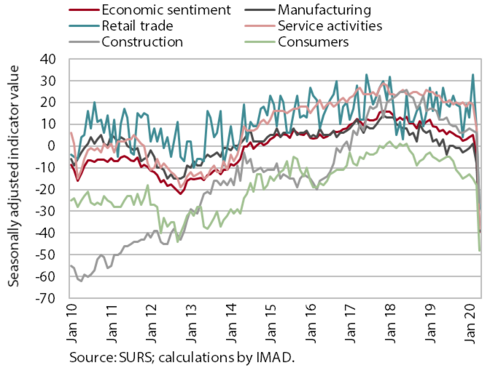
Confidence in the economy deteriorated strongly in April, reaching a 15-year low. Due to the spread of the coronavirus epidemic, all activities recorded not only a significant deterioration in the situation indicators, but also a sharp decline in expectations. Confidence dropped the most in service activities and retail trade. In April confidence in all activities (with the exception of construction) was lower than during the economic and financial crisis ten years earlier. Consumer confidence also fell, to its lowest level since the first measurement (since 2005).
Electricity consumption, April 2020
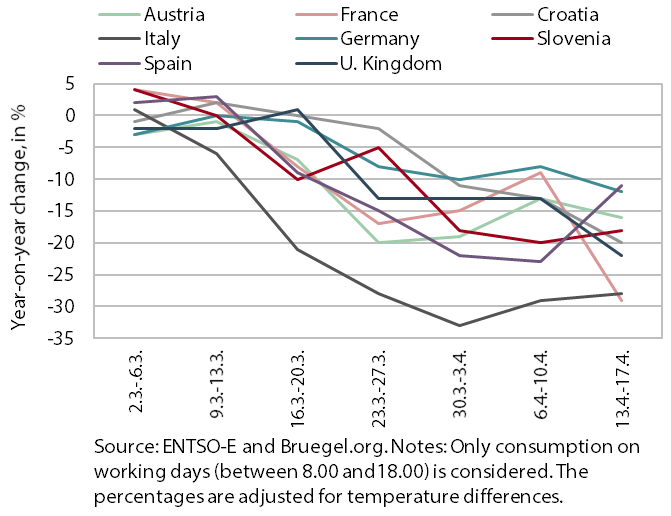
The decline in electricity consumption, which is one of the indicators of economic activity, slowed somewhat in Slovenia in the week after Easter. Data show that consumption was 18% lower than in the same week last year,* while in the week before it was 20% lower. Other countries shown in the figure have not yet seen any visible signs of increased consumption either, with the exception of Spain, which last week started to relax the measures taken to stem the coronavirus spread.
____
* For the sake of comparability with other countries, this year’s Easter Monday and last year’s Friday before Easter are not included in the calculation, which means that only three days are taken into account (Tuesday to Thursday).
Transport by electronically tolled vehicles* on Slovenian motorways, April 2020
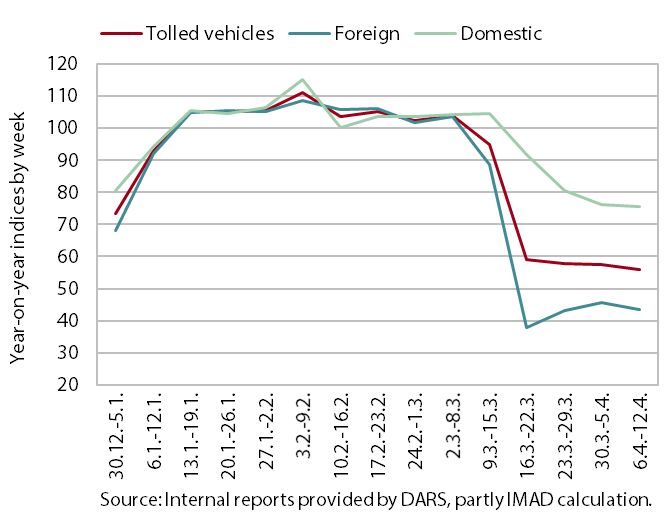
Freight transport on Slovenian motorways has declined noticeably since the declaration of the epidemic. While after the enforcement of domestic and foreign containment measures in the middle of March, transport by trucks (measured by the number of kilometres driven) fell by more than 40% year on year, it improved in the week after Easter.** At the beginning of the epidemic, the decline in transport by foreign trucks (by more than 60%) significantly exceeded that in transport by domestic trucks, but in the week after Easter the difference narrowed slightly. The smaller decline in transport by foreign trucks after Easter may also be a result of EU measures to ensure the free flow of goods across borders and the relaxation of measures in some neighbouring countries.
____
* The electronic tolling system applies to vehicles whose maximum permissible weight exceeds 3.5 tonnes. As these vehicles predominate, we speak simply of freight vehicles/trucks.
** Because of the public holiday, we adjusted the number of days included in the calculation. As the weekend and public holiday driving bans for trucks currently do not apply, we also excluded Saturday and Sunday from the calculation.
Slovenian industrial producer prices, March 2020
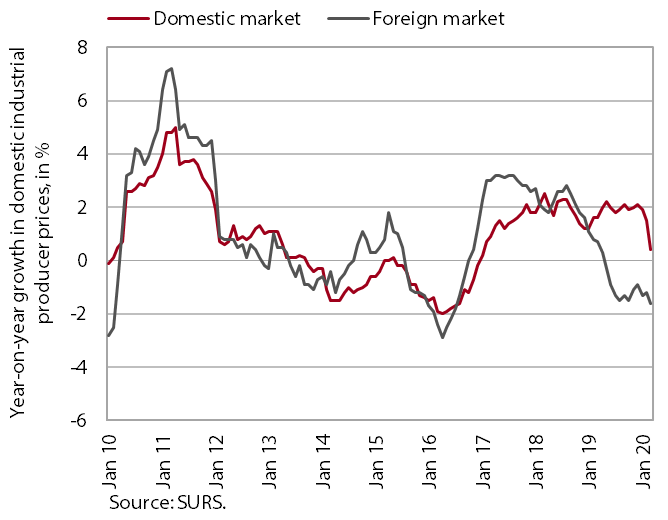
Slovenian industrial producer prices were lower year on year in March (by 0.6%), for the first time in more than three years. The fall was mainly due to a pronounced moderation of price growth on the domestic market, where electricity prices declined due to Government measures taken to mitigate the consequences of the epidemic. The drop of raw material prices also deepened slightly. The growth of consumer goods prices strengthened somewhat further. On foreign markets, the decline in Slovenian producer prices increased slightly again, mostly due to a larger decline in prices of consumer goods.
Tourism, February – March 2020
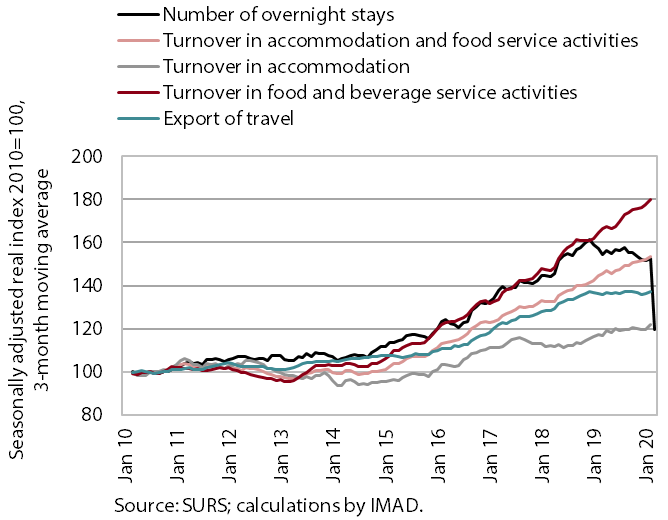
Because of the coronavirus epidemic, the number of tourist arrivals plunged in March, which will affect turnover in accommodation and food service activities, which had otherwise still increased in February. The growth in February was attributable to the further spending by the domestic population and the increase in overnight stays and consumption of foreign tourists, same-day visitors and transit guests. In February the coronavirus epidemic was reflected only in a fall in overnight stays of Asian tourists in Slovenia (year on year almost by one fifth), while the number of all foreign tourist overnight stays together was 3.7% higher than a year earlier. With the spread of the coronavirus in Europe and the closure of all hotels and restaurants in Slovenia, the number of all overnight stays dropped by two thirds year on year in March, which will have a significant impact on turnover in accommodation and food service activities.
Trade, February – March 2020
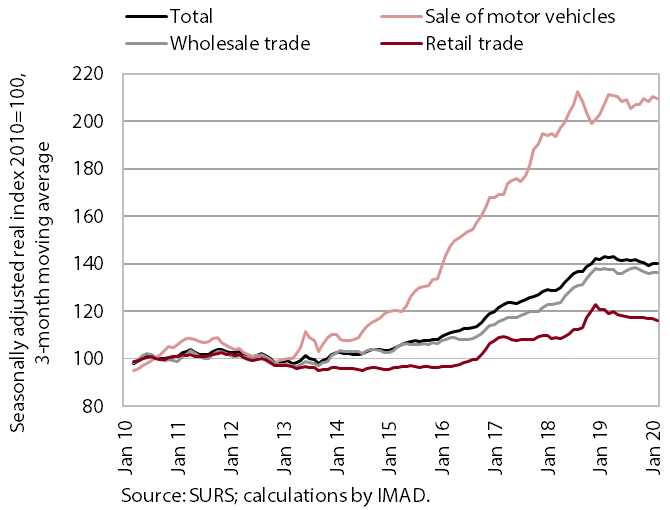
At the beginning of the year, turnover in trade remained similar to that at the end of last year, while in March it fell sharply in some segments. The favourable developments in the first two months reflected further moderate growth in private consumption and strong activity in some trade-related sectors (manufacturing, construction, transport, etc.). With the spread of the coronavirus epidemic in Slovenia and the closure of shops selling non-essential goods in the middle of March, the situation in the trade sector changed significantly. Turnover in the sale of food products, which had already increased significantly in February under the influence of uncertainty, rose further in March according to preliminary data. On the other hand, due to the closure of shops selling non-essential goods, turnover in retail sales of non-food products and motor vehicles dropped sharply in March (by more than a quarter and more than a third respectively).
Market services, February 2020
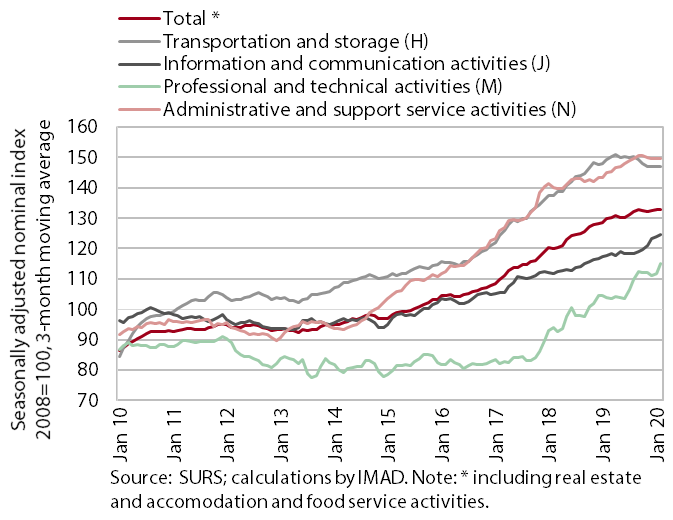
The weak growth of turnover in market services continued in February, when the impact of the coronavirus spread was not yet felt, but we expect a decline in the coming months. In February, turnover in transport and administrative and support service activities remained at the same level as at the end of last year. With rising export revenues in computer services, turnover growth in information and communication activities was still high. Because of considerable growth in architectural and engineering services, turnover growth in professional and technical activities even accelerated. We expect that the lower economic activity in Slovenia and the EU in March and April will have a significant negative impact on service activities (especially transport and business activities).
